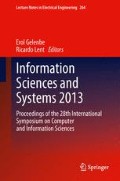Abstract
Selecting a suitable sensor configuration is an important aspect of recognizing human activities with wearable motion sensors. This problem encompasses selecting the number and type of the sensors, configuring them on the human body, and identifying the most informative sensor axes. In earlier work, researchers have used customized sensor configurations and compared their activity recognition rates with those of others. However, the results of these comparisons are dependent on the feature sets and the classifiers employed. In this study, we propose a novel approach that utilizes the time-domain distributions of the raw sensor measurements. We determine the most informative sensor types (among accelerometers, gyroscopes, and magnetometers), sensor locations (among torso, arms, and legs), and measurement axes (among three perpendicular coordinate axes at each sensor) based on the mutual information criterion.
Access this chapter
Tax calculation will be finalised at checkout
Purchases are for personal use only
Notes
- 1.
The sensor configuration at full capacity implies the configuration employing all available sensor types, sensor locations, and measurement axes.
References
Kim E, Helal S, Cook DJ (2010) Human activity recognition and pattern discovery. IEEE Pervas Comput (1):48–53
Preece SJ, Goulermas JY, Kenney LPJ, Howard D, Meijer K, Crompton R (2009) Activity identification using body-mounted sensors-a review of classification techniques. Physiol Meas 30(4):R1–R33
Turaga PK, Chellappa R, Subrahmanian VS, Udrea O (2008) Machine recognition of human activites: a survey. IEEE T Circ Syst Vid 18(11):1473–1488
Altun K, Barshan B (2012) Pedestrian dead reckoning employing simultaneous activity recognition cues. Meas Sci Technol 23(2):025103
Töreyin BU, Dedeoğlu Y, Çetin AE (2005) HMM based falling person detection using both audio and video. In: Sebe N, Lew M, Huang T (eds) Computer Vision in Human-Computer Interaction. Lecturer Notes Computational Science, Springer, Berlin, pp 211–220
Ganyo M, Dunn M, Hope T (2011) Ethical issues in the use of fall detectors. Ageing Soc 31(8):1350–1367
Preece SJ, Goulermas JY, Kenney LPJ, Howard D (2009) A comparison of feature extraction methods for the classification of dynamic activities from accelerometer data. IEEE T Bio-med Eng 56(3):871–879
Altun K, Barshan B (2010) Human activity recognition using inertial/magnetic sensor units. In: Salah A, Gevers T, Sebe N, Vinciarelli A (eds) Human Behavior Understanding. Lecture Notes Computational Science, Springer, Berlin, pp 38–51
Atallah L, Lo B, King RC, Gitang G-Z (2011) Sensor positioning for activity recognition using wearable accelerometers. IEEE T Bio-med Circ Syst 5(4):320–329
Fish B, Khan A, Chehade NH, Chien C, Pottie G (2012) Feature selection based on mutual information for human activity recognition. 2012 IEEE International Conference Acoustics Speech. pp 1729–1732
Yüksek MC (2011) A comparative study on human activity classification with miniature inertial and magnetic sensors, MSc. thesis, Department of Electrical and Electronics Engineering, Bilkent University, Ankara, Turkey
Altun K, Barshan B, Tunçel O (2010) Comparative study on classifying human activities with miniature inertial and magnetic sensors. Pattern Recogn 43(10):3605–3620
Xsens Technologies BV (2010) MTi and MTx user manual and technical documentation, Document MT0100P, Revision O
Cover TM, Thomas JA (1991) Elements of Information Theory. Wiley, New York
Li W (1990) Mutual information functions versus correlation functions. J Stat Phys 60(5–6):823–837
Author information
Authors and Affiliations
Corresponding author
Editor information
Editors and Affiliations
Rights and permissions
Copyright information
© 2013 Springer International Publishing Switzerland
About this paper
Cite this paper
Dobrucalı, O., Barshan, B. (2013). Sensor-Activity Relevance in Human Activity Recognition with Wearable Motion Sensors and Mutual Information Criterion. In: Gelenbe, E., Lent, R. (eds) Information Sciences and Systems 2013. Lecture Notes in Electrical Engineering, vol 264. Springer, Cham. https://doi.org/10.1007/978-3-319-01604-7_28
Download citation
DOI: https://doi.org/10.1007/978-3-319-01604-7_28
Published:
Publisher Name: Springer, Cham
Print ISBN: 978-3-319-01603-0
Online ISBN: 978-3-319-01604-7
eBook Packages: Computer ScienceComputer Science (R0)

